I’ve been a content creator for over a decade and can command upwards of $1k per article as a freelance writer. I have also created hundreds of videos for various YouTube channels and recorded some podcasts with the CEO of a marketing agency in Miami that I work with.
I am not saying that to brag. Anyone with a Smartphone and an internet connection can publish digital content, go viral, and theoretically reach a global audience. Maybe you’re a one-minute vertical video away from glory!
But the competition in the creator landscape today is also daunting.
Where do you start content creation?
Should you build your own content creator business?
Is content marketing a viable industry to make a successful career?
In this article, you’ll get some practical tips for becoming a content creator based on my experience.
What is a Content Creator?
A content creator crafts digital media — text, video, or audio — for a specific platform to resonate with a well-defined audience. They generally try to entertain, educate, inspire, and occasionally persuade their audience. The content you may create includes newsletters, blog posts, podcasts, social media posts, vlogs, Ebooks, and the like.
A 2022 survey by TheTilt found that creators use the following channels to reach their audiences:
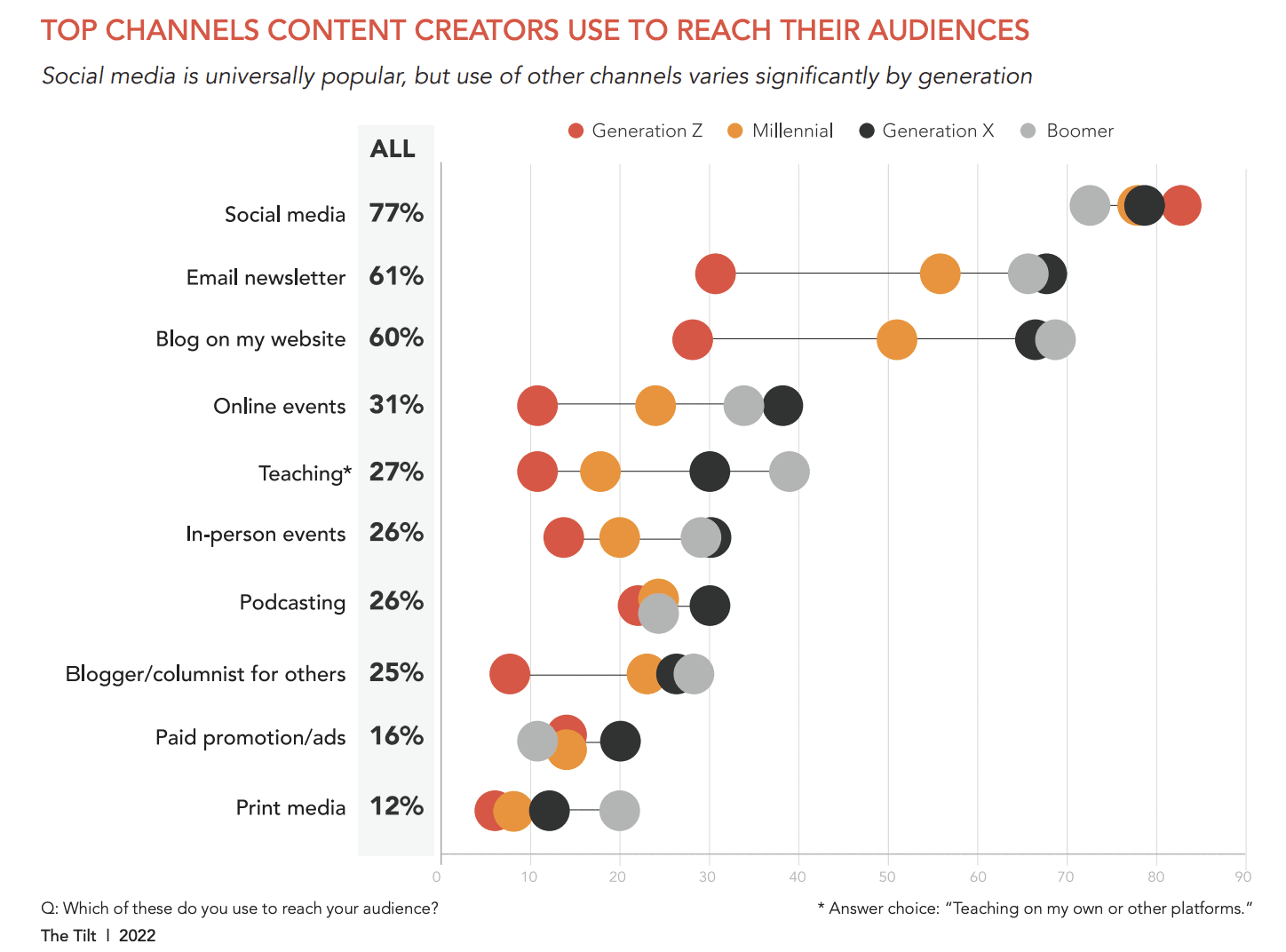
What are The Types of Content Creators?
In digital marketing, you can create different types of content, leading you to become a unique creator. Here are just a few examples of content creators:
- Social media influencer
- Freelance writer
- Blogger
- Video creator
- Podcaster
- Newsletter author
- Digital publisher
Brands now employ all of the above kinds of creators in content marketing roles to reach their prospects. It can mean one creative professional writing blog posts for them, another producing video content for their YouTube channel, and a third managing their social media presence. So whatever talent you have, there are ample opportunities for you.
How Do Content Creators Make Money?
Depending on the influence, the platform they primarily create content for, and the business model, content creators monetize in the following ways:
- Ad revenue: Get paid for eyeballs (called “impressions” in advertising terms) and clicks you generate on ads that appear on your website, YouTube channel, etc.
- Brand sponsorships: Collaborate with businesses to promote their products through sponsored posts, product reviews, or brand mentions.
- Affiliate marketing: Promote other products by using your affiliate link and earn a commission when someone buys through you.
- Coaching and consulting: Offering content creation, strategy, and mentorship to brands or other creators.
- Selling digital products and subscriptions: Sell your Ebooks, online courses, templates, or other exclusive content with a select group of people behind a paywall.
What Does a Content Creator Do?
Being a content creator is a real, full-time job. Here are some roles and responsibilities you play as one:
1. Craft a Content Strategy
Before creating, you need to know your audience and develop an overarching strategy that dictates your efforts. As a content marketer, you may prepare a strategy for specific marketing channels such as SEO, social media, or an email newsletter.
Even if you’re an individual creator building your personal brand, you should document the guiding principles of your content creation. Here are some elements you need to keep in mind:
- Establish who you are: The tone and voice are important ingredients that will determine a brand’s style. As an individual creator, you should choose to stay authentic (because it works!)
- Your target audience and topics you’ll cover: Defining who you want to reach, their goals, pain points, and desires is powerful. It can help to identify broad topics of interest for them and uncover relevant content ideas.
- Business goals: Do you want to reach more people (followers, traffic, pageviews), generate leads, or sell more products? You need to know the desired business outcomes to align your creation efforts.
- Create a content calendar: How often will you publish? What are the next few content pieces you’ll work on? You need to plan for a few weeks ahead (if not more) to ensure you publish content consistently.
- Choose your marketing channels: Will you promote your content through SEO or social media? Depending on where your target audience hangs out, you need to plan to get the word out for every content piece you put out.
2. Create Content
The next step is the creation of the content itself. You need to write, record, design, or produce content based on the strategy you have put in place. It may mean you follow a content brief given by your content manager.
You want to structure and refine your content based on the channels where you want to distribute it. SEO content published on websites calls for using suitable heading tags, images, and trying to serve the “intent” of a searcher for your chosen topic. Content for social media and emails is typically free flowing and opinionated.
For richer media assets such as audio and video, you may rely on podcast recording, video editing, graphic design, and related tools. Before you press publish, you need to polish and adhere to quality standards set by yourself or the brand you’re working with.
3. Promote Content
Your content will likely get lost in the sea of millions of pages, social media posts, or YouTube videos published every day unless you distribute the content on specific platforms.
If you’re relying on SEO, there are various on page SEO tools, such as Surfer SEO, that help to optimize your text to rank in organic search. If you want to get attention on Instagram, TikTok, or another medium, you ideally want to create secondary “native” content pieces that are meant for consumption on these platforms themselves.
It could mean repurposing your blog post into a Twitter thread. If you produce a video podcast, you can create short and intriguing video clips from it that create awareness about your longer version.
Ultimately you want to maximize the amount of awareness and engagement you can get from every piece of content you create.
4. Engage With Audience
Once you have got the word out, you may get replies from your audience and engagement on your posts. To foster a thriving community, you need to interact with your audience. Check what they like and dislike. Respond to their comments and use their feedback even to inform your content creation efforts.
5. Analyze and Iterate Their Content Creation Efforts
Always keep an eye on the performance of your content. Is it meeting the goals you set while building a content strategy? How engaged is your audience? You can use a tool like Google Analytics to check the performance of the content on your website.
Most social media platforms, such as YouTube, have their own analytics tools as well. They can provide you with cool insights into where most of your audience drops off, their average view duration, etc. You want to learn the analytics of the primary platform you create content for and improve your content creation based on the insights you derive.
While you need to refine your creator muscles and other marketing skillsets, 94% of creators in The Tilt survey (we referred to above) say, “You don’t need a four-year college degree to be successful as a content creator.” Many six-figure freelance writers or YouTube creators today thrive without a formal education in Communications and the like.
How to Become a Content Creator: 6 Tips
Let’s look at a few habits, principles, and tips to become a high-quality content creator. I might mostly refer to textual content creation in the pointers below, but the overarching ideas are valid for video creators, podcasters, and all other kinds of creators.
1. Niche Down So That You Can Scale Up
When I began content creation, I got paid a tad over 50 cents for a 500-word blog post. To date, content mills and freelance marketplaces continue paying $5 per article to new writers. In the iWriter pricing plans below, look at the pay for the “Standard” tier.
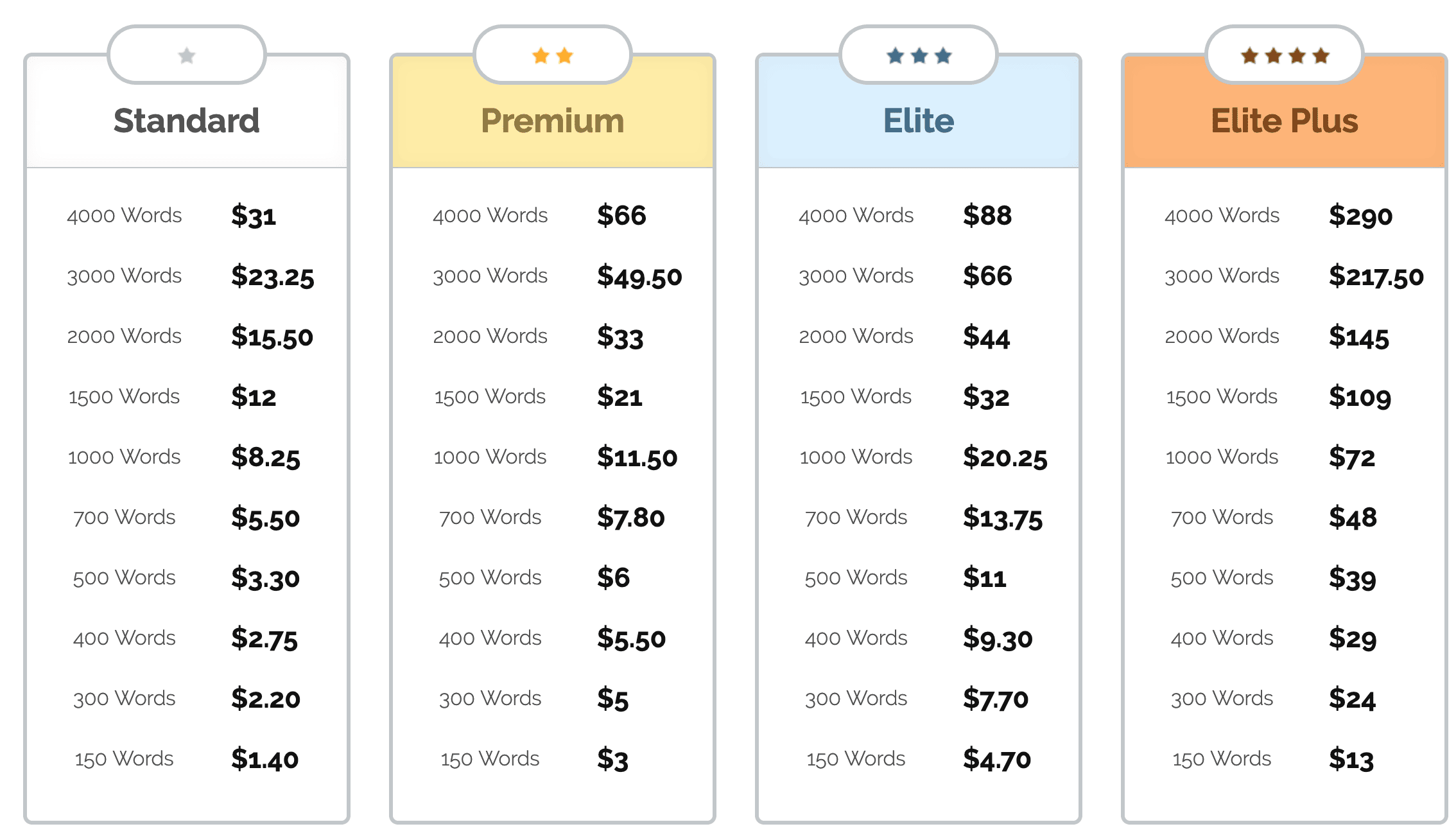
Working for such content creation companies that deem it as a commodity is a huge mistake. It shouldn’t be on your cards (barring a few decently paying gigs at Upwork). But can you get paid well at the beginning of your content career?
It’s a reaffirming YES. Begin by niching down. Don’t try to please millions. Rather, find those 1000 true fans you would genuinely love to converse with. That’s not a big ask, given that even appealing to one-in-a-million people worldwide would leave you with 7000 people.
Tim Ferriss, author, and entrepreneur, lays down the importance of finding this ‘narrow niche’ for yourself — about aiming for a readership that LOVES every piece of content you create.
<iframe width=”560″ height=”315″ src=”https://www.youtube.com/embed/DB_xDajqiNQ” frameborder=”0″ allow=”accelerometer; autoplay; encrypted-media; gyroscope; picture-in-picture” allowfullscreen></iframe>
I rescued my freelance content career by specializing in writing digital marketing articles and, later, SaaS content marketing. That’s how I raised my rates by over 2000x and scaled up my content business.
Whether you’re producing videos for your YouTube channel, starting a podcast, or engaging in any other creative endeavor — niche down. It’s going to build a strong foundation for scaling up your audience or your pay later on.
Want to create a persona of your “true” fans? Get started with this free Make My Persona tool by Hubspot.
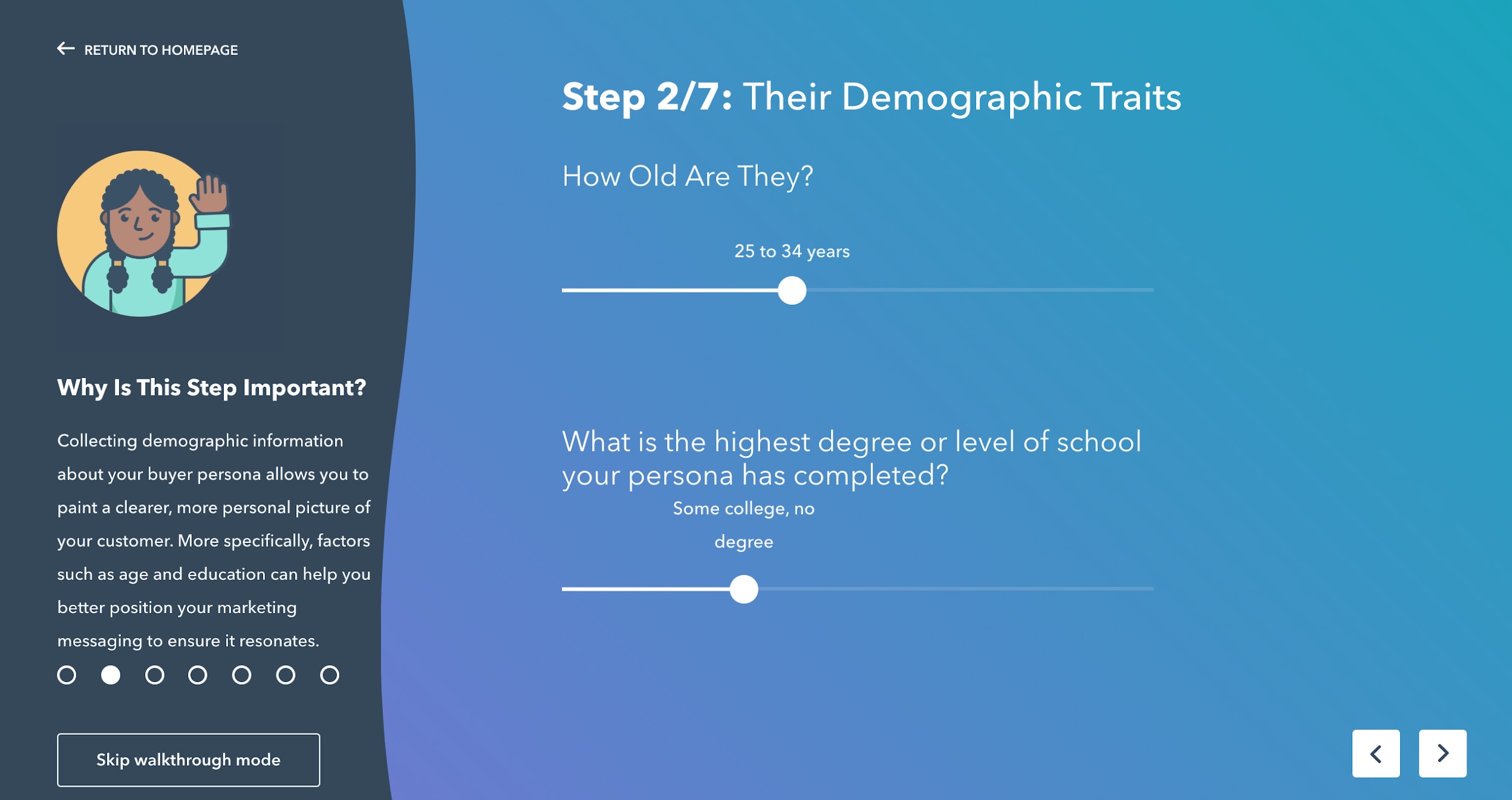
2. Build Streaks To Gain Momentum
Whenever I’ve set huge goals for myself related to creative projects — be it writing or producing videos — I’ve felt overwhelmed. I almost always backed out even before starting the project. I learned the hard way that the key to flexing your creative muscles is just by showing up regularly and completing mini-tasks.
If you’re getting started with a blog, you need not write 1000 words every day. Just promise yourself to put down 100 words a day and build a streak of the same. The idea is to set the bar so low, you won’t feel any resistance in showing up.
Especially at the beginning of a creative project, such streaks help you feel confident and gain momentum. I’ve found them helpful in building an appetite for taking on bigger challenges. For instance: Once you get the foot in the door with those first 50 words — you’ll feel inertia to continue writing. Who knows, you might even complete a whole article.
I like using the Strides app (available on iOS and the web) to keep track of my habit streaks. Here’s a preview of me trying to “play the guitar” every day. I’m trying to improve the percentage of days I show up.
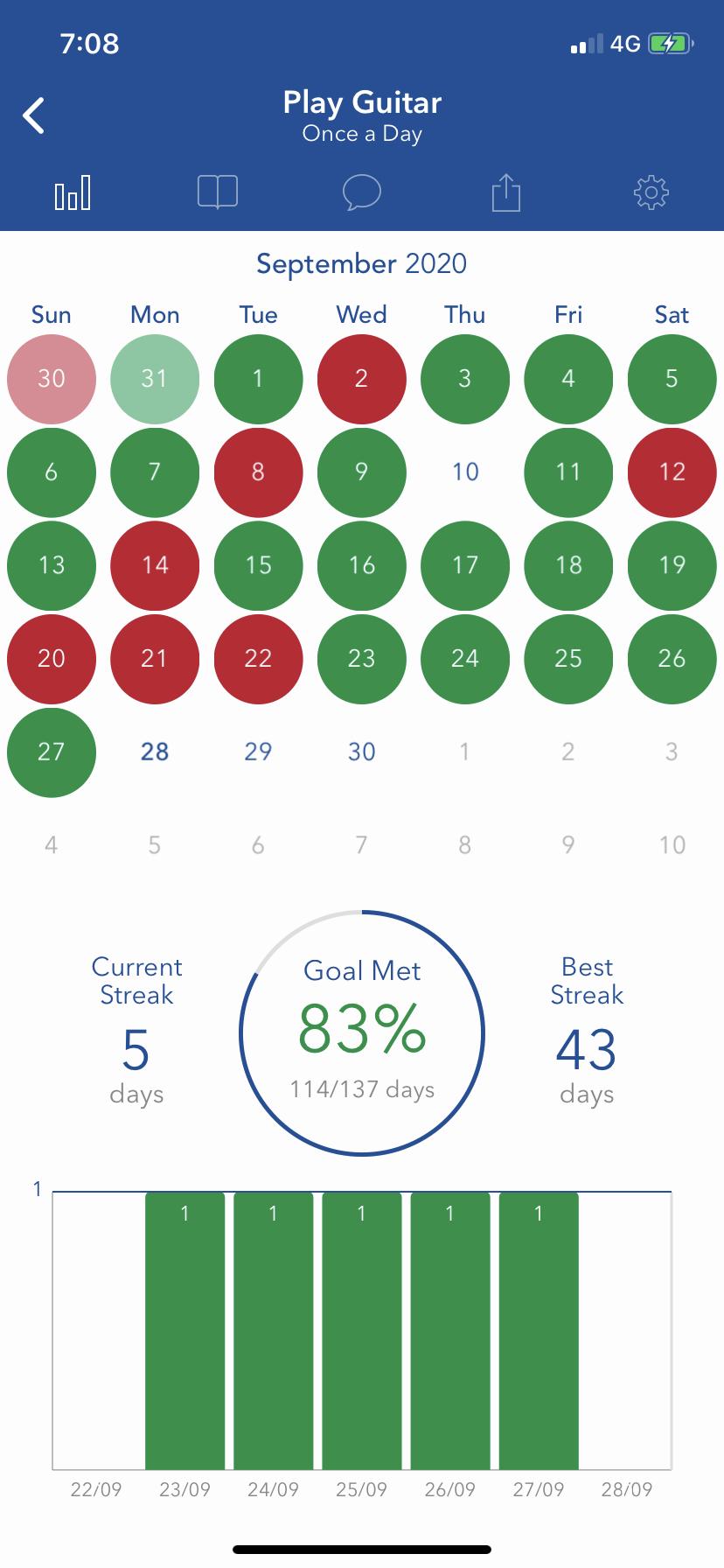
Building such streaks can also take a weekly form. James Clear (author of Atomic Habits) chose a frequency of publishing two articles per week at the beginning of his blogging journey. That has paved his way to becoming a bestselling author and a super successful blogger.
One fine day, James didn’t feel like he had any great ideas and wanted to give up.
So what did he do?
He used some grit and wrote anyway.
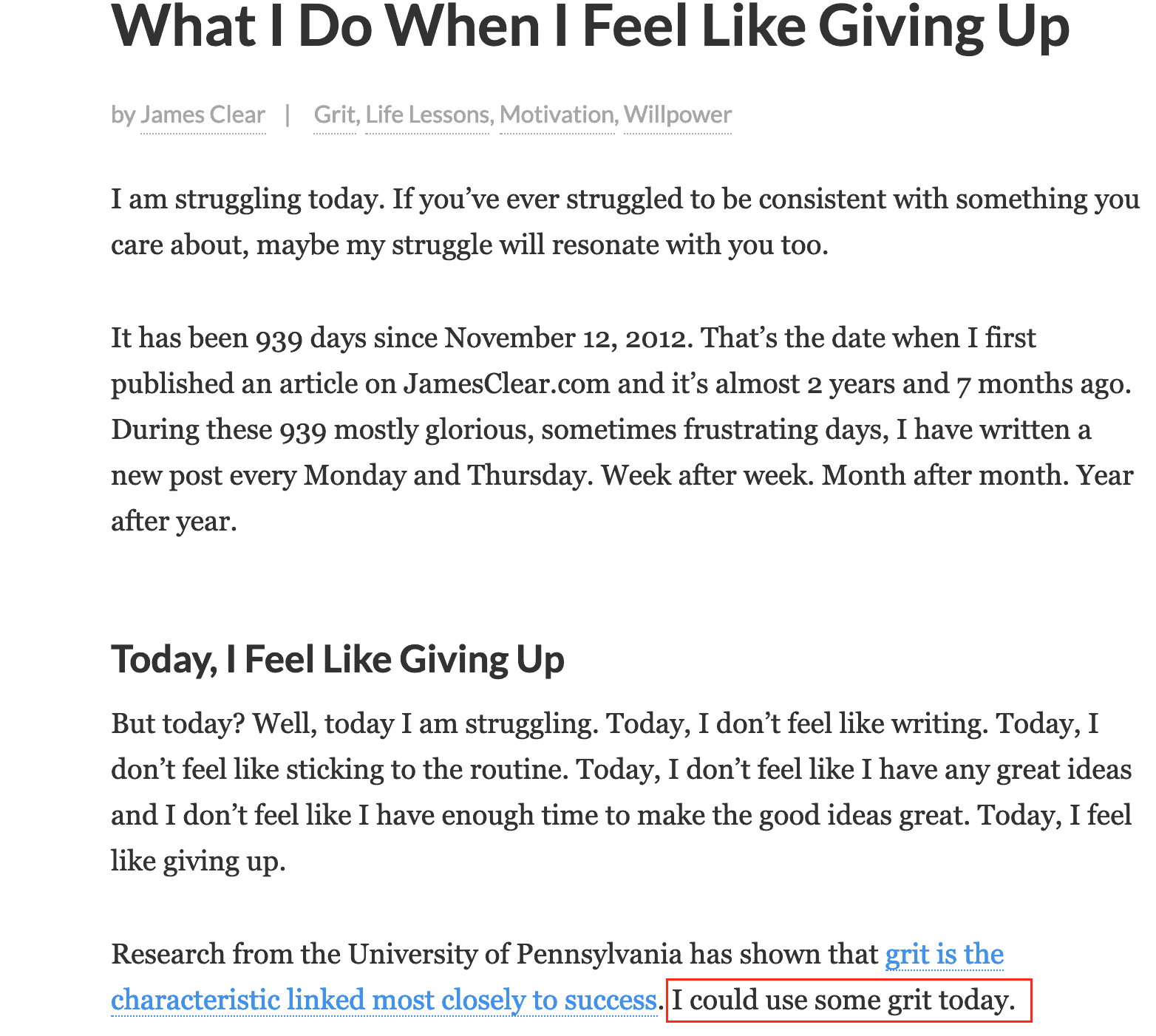
Later in the article, I’ll share another application that will help you understand your body’s internal clock so you can build your writing routine accordingly.
3. Copy Badasses In Your Industry
I’m not talking about plagiarising content. I want you to scout writers, authors, podcast hosts, artists, or any other creative influencer you admire and try to emulate their style.
Maybe you’re a video creator and connect with someone like Gary Vaynerchuk. He shares valuable advice for aspiring entrepreneurs, a common subject. But his videos have a characteristic GaryVee exuberance, so you dissect that by watching his videos.
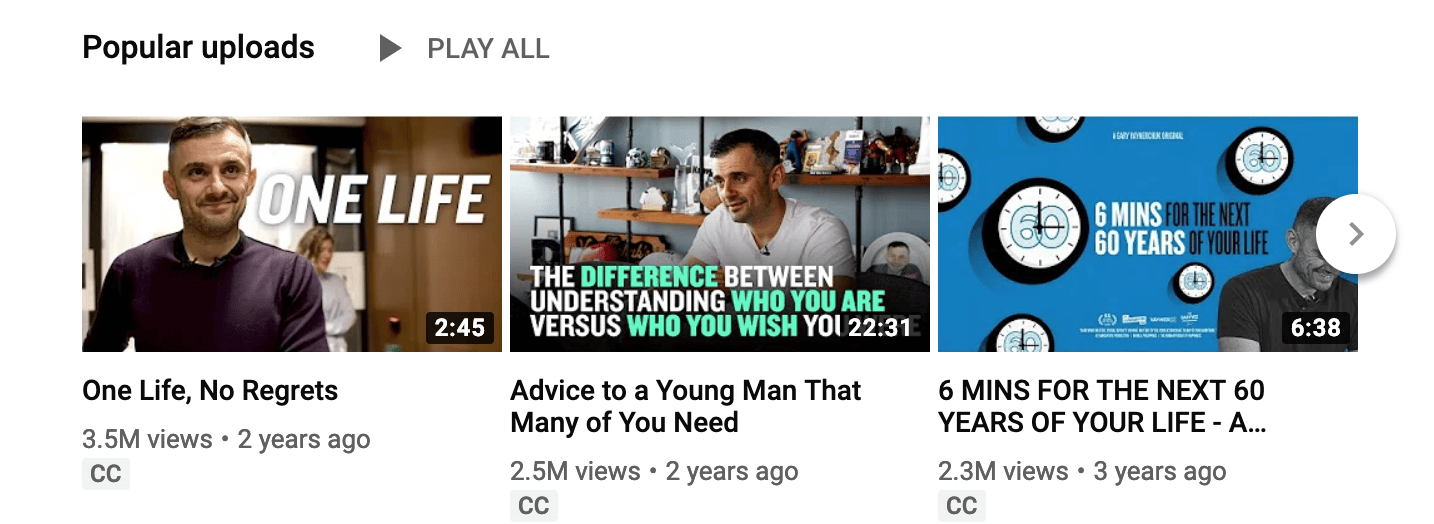
His tone overflows with energy, swearing, and hustle. He isn’t worried about being politically correct. He doesn’t want to appeal to everyone. So you can take the best parts of his approach.
For a content writer, it could mean reading articles at the New York Times or their favorite blog, then dissecting their punctuation usage, framing of arguments, sentence structure, and even memes. You can do this for a bunch of your favorite writers.
Conduct the above exercise whenever you want some inspiration — until you realize that you’ll only fail at becoming these artistic folks — and in the process, you find your style, your voice.
It’s combinatorial creativity at work. As Maria Popova, author and the founder of Brain Pickings, says, “We take information, from it synthesize insight, which in turn germinates ideas.”

Note: Especially while creating content in crowded industries such as business and marketing, it’s important to speak and write from personal experience, all while taking inspiration from the greats you feel inspired by. Your authentic voice is your only defense against competition.
4. Leverage Data To “Inform” Your Content Creation, BUT…
Content is a marketing channel. So it’s important for your writing, videos, or any other creative project to help the business bottom line, and data can be a great indicator of it. For instance, you can measure:
- brand awareness (traffic),
- leads (newsletter signups, product trials and demos, and the like),
- and sales (direct revenue).
So install Google Analytics (GA) on your website to keep track of your content performance and insist your clients do the same. Besides your website, all other platforms (YouTube, Spotify, Twitter, Facebook, you name it) you create content for will have dedicated analytics.
For instance, here’s a snapshot from GA for my article: things to write about. It gets pretty slick engagement, but I can work on reducing the bounce rate of the article.

Indeed, depending on your goals, you can set up key performance indicators (KPIs) to evaluate your content. It can include generated product trials, newsletter signups, average engagement rate, etc.
Let me share an example to illustrate a few KPIs:
- A comparison review article like “best online course platforms” will appeal to course creators who want to purchase course software. It need not generate a lot of traffic, but it should generate product trials.
- Now consider an informational article like “getting high-paying ghostwriting jobs.” It should appeal to freelancers who want to make money writing. If the readers find it valuable, it should generate newsletter signups.
For content creators, traffic, pageviews, search traffic, keywords ranked, and such could be decent starting points. But if you’re not a publisher monetizing your content with advertisements, these are all vanity metrics — because none of them would directly be attributed to your revenue. Choose a metric as close to your bottom line as possible.
At the end of every month, you can review your data, check the performance of your content against your KPIs, and try to answer questions such as:
- What kind of content you created is performing the best vs. the worst?
- How many articles is a typical website visitor reading when they come to your site?
- What is the difference in behavior between a mobile vs. desktop visitor?
You’re looking to accrue insights from these questions so that you can iterate your process of content creation. It might mean you find something that goes against your gut. What should you do in such situations? Well, you need to:
5. Create A Portfolio You’re Proud Of…
Your intuition can derail you, so coupling it with data to inform your content creation is fine and dandy. But let’s look at a special scenario:
Data says that certain kinds of review articles are performing the best. You feel bored exclusively writing them alone, though. You want to experiment with newer and exciting content formats.
Well, for me, the joy of creation can’t be compromised consistently. If you want to play the long game, some stats about YouTube or best practices about adding tags in your videos can’t be your guiding light.
A creative career in content calls for building a strong body of work — something you feel excited about even while putting sweat equity and something you feel proud of — and that can’t happen with “safe” career choices and “proven” frameworks alone.
You need to take risks and let your curiosity guide you — maybe even when data tells you otherwise and even when it doesn’t seem to have financial potential. Remember your portfolio reflects your creative potential and will result in career opportunities of that magnitude.
6. Don’t Work On Your Content Creation Skills
When I started a creative career, I felt outraged at creative professionals who I “felt” were undeserving of their fame and wealth.
My judgemental notions were brought to rest when I read a thing or two about gatekeepers — the influential people who control access to audiences, evaluate the quality of work, and decide who becomes the next BIG thing!
Beyond your core content creation skills, becoming a successful content professional calls for working “on your career.” You need to understand what Cal Newport, the author of Deep Work, calls meta-knowledge.
Here’s how he defines it: “Meta-knowledge is knowledge about how your career works. For example, which skills matter, and which you should ignore, and how best demonstrate your talent in your particular industry, and so on.”
So do yourself a favor by understanding the business of content marketing. Building a reputation for yourself requires networking with influencers. Having a decent-sized email list and snagging appearances in industry publications (through interviews, guest posts, collaboration, and the like) also helps.
Think of someone like Aaron Orendorff, who is a marketing leader at an established company. He began his journey as a copywriter and guest posted on every major marketing blog.
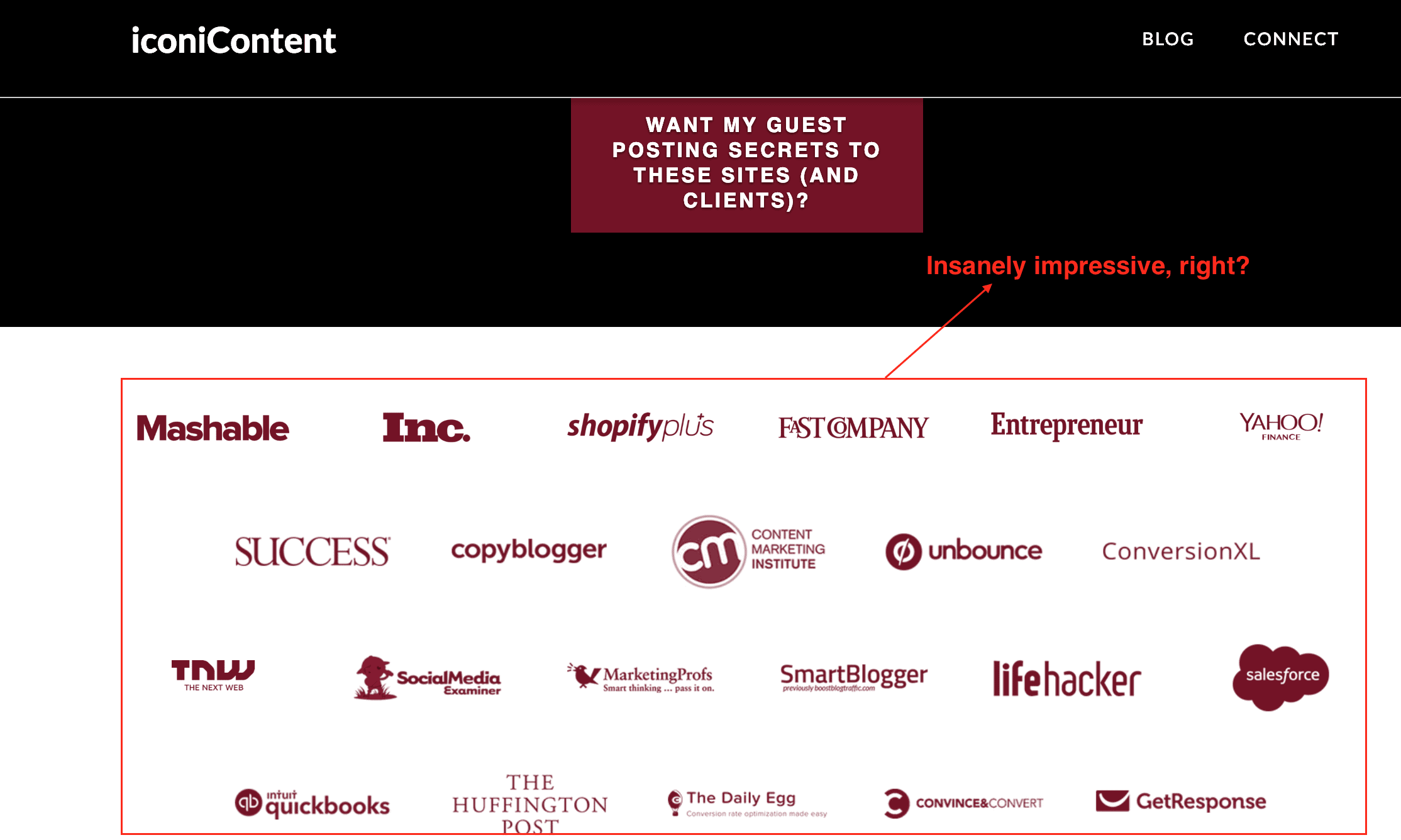
He refined his skills based on feedback from editors and gatekeepers from huge publications. It not only gathered social proof, but he understood the kind of writing expected by these established brands. And his focus on quality helped him get “discovered” by Ann Handley, a marketing influencer — that’s when his career gained momentum.
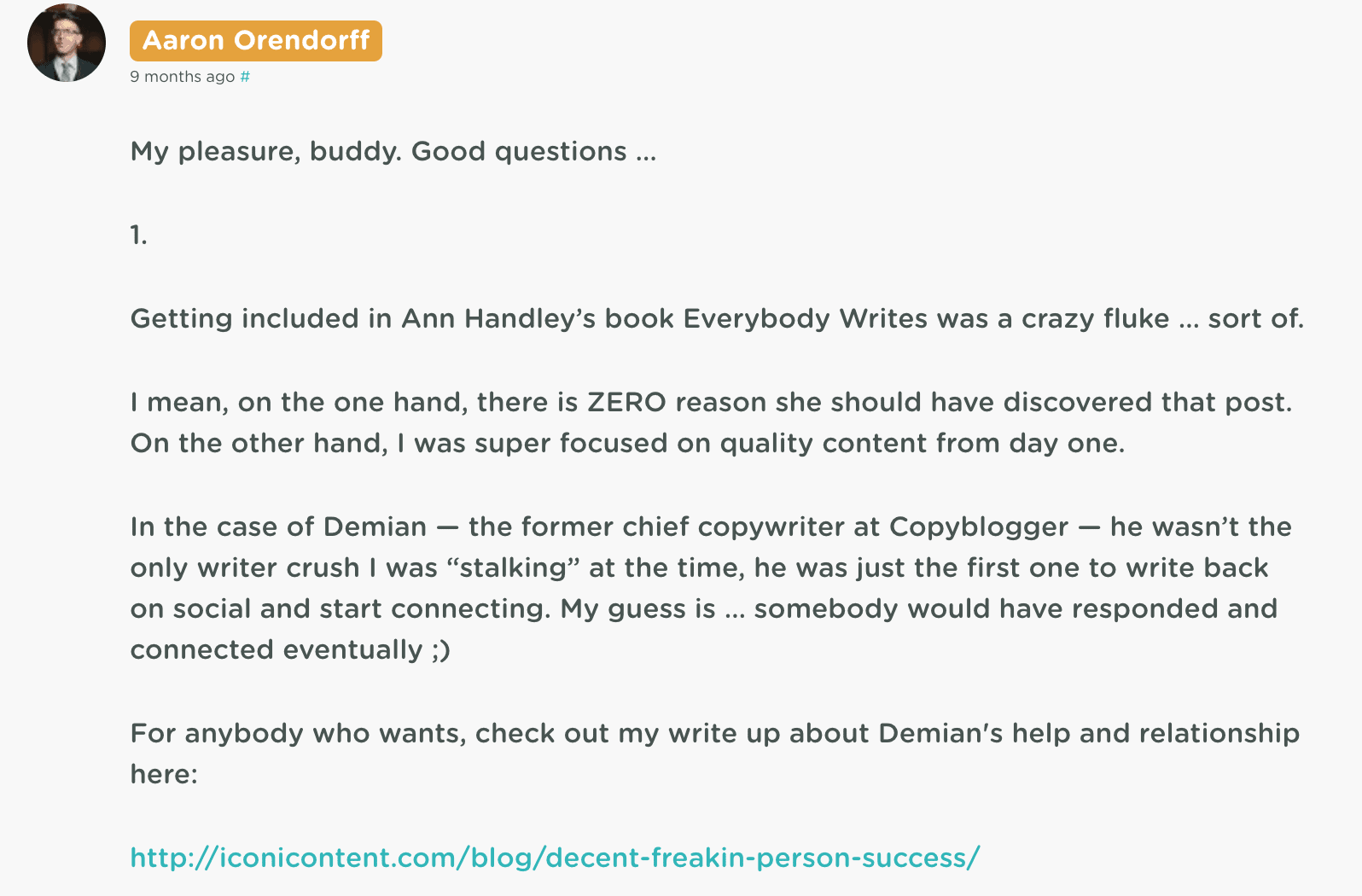
Influencer outreach, relationship building, and collaborating with other creators will pay you off — often even more than creating content. Alongside this, if you can start an email list, you’re giving yourself all the security you can get with a creative career.
Where to Find Work as A Content Creator?
If you’re looking for salaried content roles, here are some places to start your search.
- LinkedIn Jobs: The world’s biggest platform where you may find a content creator job based on location, experience, and industry.
- Wellfound: Another great professional job board, but majorly focused on startups. You’re highly likely to work with a cool company ready to work remotely (wherever you’re in the world) here.
- Superpath Job Board: This is a niche job board specifically for full-time content marketing roles, though you may find some freelance opportunities here.
- Problogger Jobs: A great freelance writing job board for decently paying B2B blogging opportunities. I landed my first major, stably paying content writing gig from here.
- Upwork: You may find freelance job posts here for video editing, writing, editing, design, and lots of other kinds of roles. It’s a good platform to get your feet wet in content creation, but be wary of using it long-term (because freelance marketplaces tend to pay low).
You can also use Twitter, Facebook, and your personal network to land some content roles. I also recommend you do cold email outreach to successful creators in your niche that you like. Maybe they can offload some of their work by hiring a video editor or writer, and you fit their needs.
How Much Do Content Creators Earn?
As per Zippia, the average salary for a content creator is $61,988 in the US. It comes down to an hourly rate of $29.80. But at the entry level, you can expect to get paid $38,000 per year.
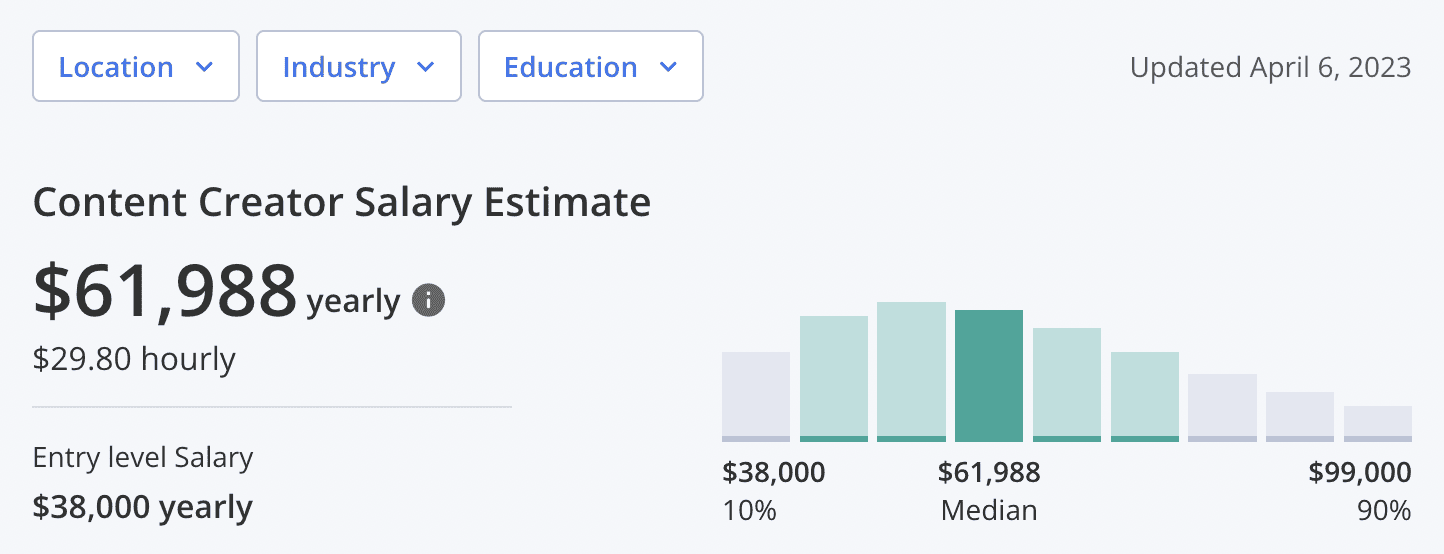
What if you want to create an independent content creator business and go for the millions?
While it’s not uncommon for self-employed freelance writers to make six figures and YouTube creators to earn even millions, an Influencer Marketing Hub survey paints a rather somber picture.
The majority of content creators pursue it as a side hustle making under $1,000. Around 21% make a liveable wage above $50,000 in revenue.
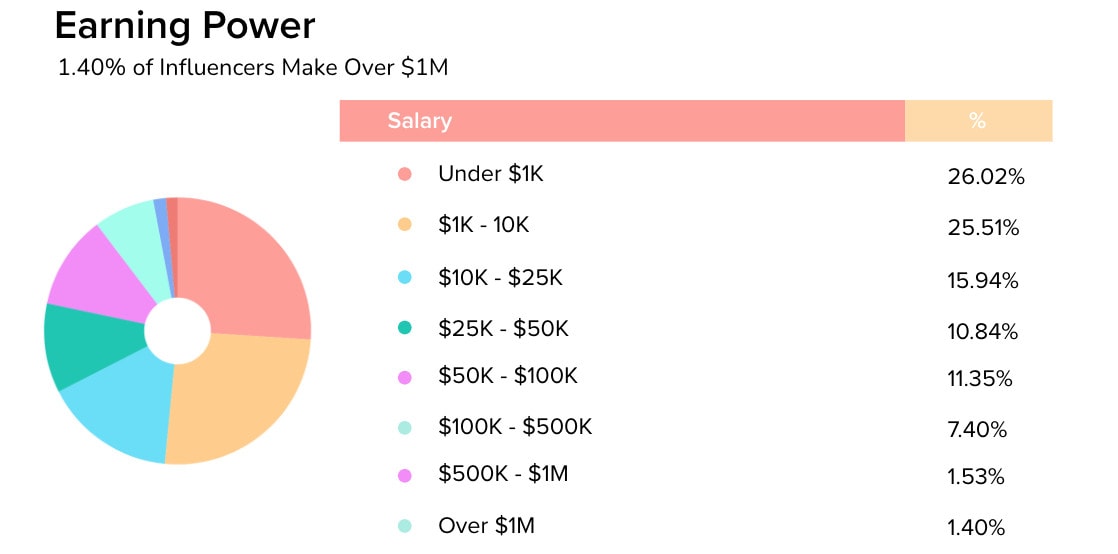
What Role Will AI Play in The Creator Economy?
You need to treat AI as a good friend and get your hands on how it can complement your content efforts. For instance, Barry Enderwick has earned 300k Tiktok followers by posting content of him making sandwiches from different periods and countries. He’s using AI even to create “sandwiches of future history.”
The truth is AI creator tools have permanently changed content creation. HubSpot, in its recent AI in content creation survey, found that marketers are using AI to:
- Generate ideas
- Write copy
- Create marketing images
- Summarize text into key points
- Translate text into a different language
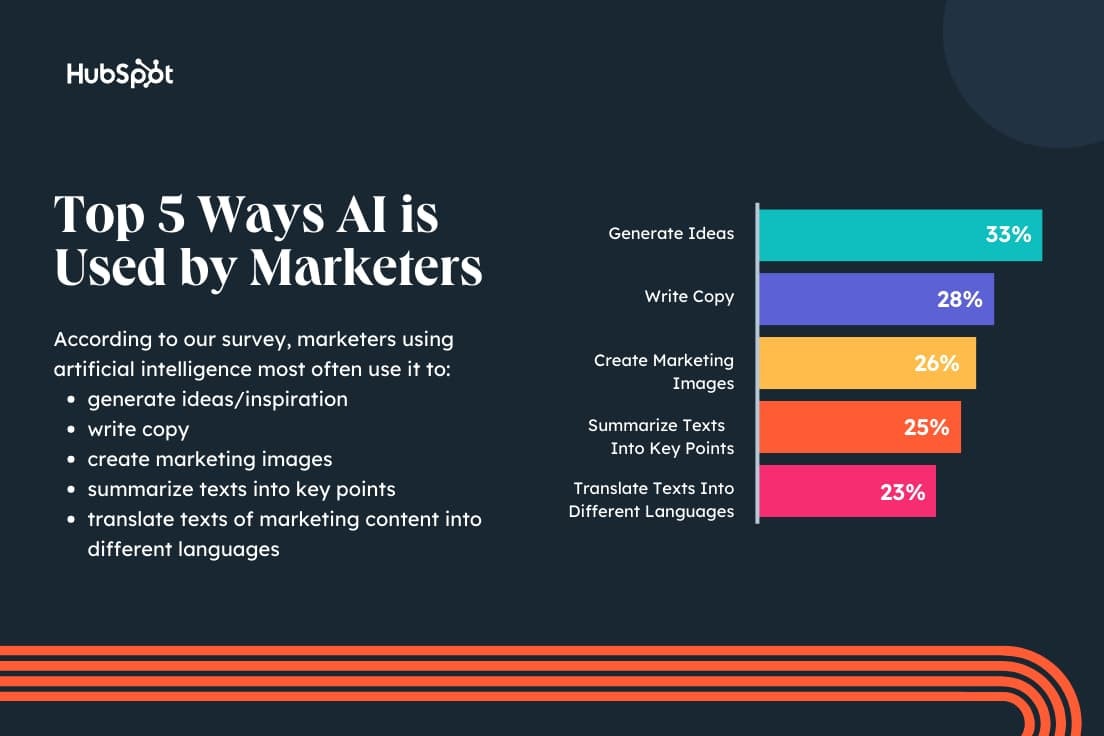
Start finding your way around these tools. Use’em to automate the tedious steps in your workflow, get some feedback on your work, or even make more content unique.
Successful Content Creators Take An Audience-First Approach…
Building a successful content creation career starts with understanding your audience. From there, it’s about finding inspiration to create regularly and finding joy in the process. During your career, go with your instincts but don’t forget to mix it up with data.
Also, don’t keep pressing publish alone — build an audience, collaborate with other creators, build relationships, and keep getting feedback about your work. All along, don’t mind using a little help from AI creator tools.
